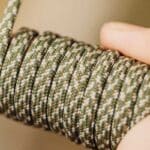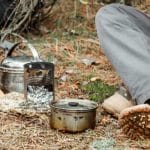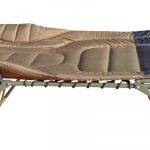Going camping is a great time to use bushcraft skills you already know and a perfect time to try new bushcraft camp projects.
I recommend packing some materials that might help, along with laying out a few bushcraft camp ideas that will come in handy if you forget something necessary, like a tent peg.
Read on to find out what you need to bring, what you can use in nature, and how to assemble the materials to realize the final projects.
Feather Stick
The number one survival tool is knowing how to build a fire. Without fire, you cannot see in the dark, cook food, or purify water.
The feather stick is a great candidate for bushcraft camp ideas and might save your life. You will need a knife, but you may get by after learning flintknapping, which you will find below.
The next thing you need to do is to find a dry area with old, dry sticks that fell from trees. You may find equally good sticks on an old log that you can break off. Take your knife and begin a combination motion of etching and slicing stick feathers or curls.
Do not cut the curls off of the sticks. Go up as far as possible on each stick until you have a handful of feather sticks. The exposed layers should light from as little as one match.
Have kindling or old pine needles ready to add to build up your fire before switching to larger sticks or logs.
Turn Plants Into Rope
Finding a suitable plant is the most challenging part of learning to make rope by hand. Some parts of the country have the perfect natural habitat for making rope, such as the Yucca plant out west.
Other regions have much softer plants that are not suitable. Find something you can cut and work into tough fibers wherever you are. Your rope will be as strong as your fibers or stronger.
Making the rope is a simple twisting and turning process that can be one of the best fun bushcraft projects.
All of your fibers will be in strands that you have to twist together. Bend your first strand into equal halves and start at the bent section. The secret to making rope is twisting together loose ends.
You will use clockwise and counterclockwise motions in unison. The steps are:
- Twist the lower strand clockwise.
- Twist the upper strand counterclockwise, and the upper strand becomes the lower strand.
- Twist the lower strand clockwise and repeat.
About halfway down, lay another strand on top to splice in and extend your rope. Repeat the same twisting motion by dividing all strands into equal halves. During some parts, you will twist two strands clockwise and two counterclockwise.
Flintknapping
The good news about flintknapping is that the skill is eminently useful as bushcraft crafts go. The bad news is that using this method to make tools is not something you will learn in a few sittings. Even masters make progress and break their creations with one flawed strike.
Flintknapping is one of the oldest surviving bushcraft skills where you form a tool, like a spearhead, by chipping away at one rock using another rock. You might see flint-knapped obsidian tools, but other materials like flint work well too.
Rocks such as granite are too hard and will not do. The best use is to make a knife for cutting carefully and deliberately because most flint-knapped tools break easily.
Bow Drill Fire-Starting
As mentioned, you should do nothing else before getting a fire going. You will be blind, hungry, thirsty, and unable to sleep without a fire. You can use the feather stick method above to help. The difference is that you may want to shave off tiny curls to ignite once your bow drill is hot enough.
A bow drill is a combo tool where you may use the rope you made to craft a bow so that you can get fire. The idea is simple. If you rub two sticks together long enough, enough friction will build enough heat to create fire, one of the most important bushcraft hacks.
The catch is that your arms do not have the stamina alone. With a bow drill, you create a lot more friction, much faster. Make a loose bow so that you can loop a stick in with one twist. You should be able to move the bow back and forth in a sawing motion and spin the stick rapidly.
Spin the stick into another piece of wood, both dry, of course. When you see smoke, carefully sprinkle in some wood shavings and gently nurture a fire.
Primitive Trapping
Unless you are a trapping expert, stick with the most basic trap of all, the deadfall trap. This method is the trap equivalent of bonking your next meal over the head with a club, good for crude but effective bushcraft things to make.
I could write an article of equal size or longer about setting up this trap, so the best thing to do is learn from a clear and concise video.
Building a Shelter
You can build many different types of shelters, and everything changes if you have something like a tarp. I am trying to stick to rugged bushcraft ideas, and the best shelter that goes up quickly and simply is a debris lean-to shelter.
The simplest shelter may be only sticks or branches with leaves spread over the top. Again, all the little steps take too long to explain in a short article, but you can make a quick and dirty shelter or a more complex version if you have time.
In Closing
You can use these bushcraft camp projects to practice while camping or before you hit the trail. If you master all these skills, you will have a substantial advantage in the wild in a survival scenario.




